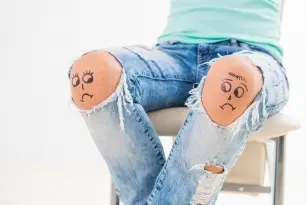
Crepitations heard in the knees are not necessarily associated with degenerative changes that are supposed to be located in the patellofemoral joint. Sometimes it is related to the wrong setting of the axis of the lower limb, or an injury, or a poorly composed diet, which may not provide us with all the nutrients necessary for the proper functioning of the joints.
Clicks in the knees can occur in each of us, both in people struggling with overweight and those who are above average athletic. It is an ailment that affects patients of all ages, and not only the elderly, as is sometimes believed.
The most common causes of creaking in the knees
Articular cartilage is responsible for cushioning and protecting the bones of the joint against unwanted abrasions against each other. While we can rule out mechanical injuries with complete certainty, the following factors can be suspected as the cause of creaking of the cartilage of the patellofemoral joint:
- anatomical defects of the joints,
- obesity,
- lack of movement,
- advanced age – cartilage wear,
- deficiencies of minerals and vitamins.
Chrondromalacia, or rather softening of the cartilage, can cause its damage. On the side of the causes of this disease, there are injuries, limb axis disorders and high growth. Due to the fact that cartilage has no innervation, pain does not make itself felt until there is a crackling sound caused by bone friction.
Methods of treatment and diet for crackling joints
It’s no surprise that untreated knee joint crepitation can lead to persistent pain accompanied by joint stiffness. To prevent this process, we should opt for sports that will not burden and will strengthen the joints. Gymnastics and swimming are noteworthy. Over time, when the joints become stronger, we can decide to go jogging or cycling. However, if the degeneration becomes stronger, manipulative exercises and physiotherapy are usually necessary. An additional benefit of exercise is keeping a slim figure, which will also protect the knee joints from excessive overload and improve blood flow.
The diet of a person exposed to joint ailments should be rich in chondroitin, collagen, glucosamines, protein, bioflavonoids, calcium and vitamins B, C and D. The menu must include dairy products, fish, legumes, sprouts, whole grain bread, brown rice, citrus, onions , garlic and olive oil. Let’s try to eat moderate portions of fat and sugars, let’s not overeat.









